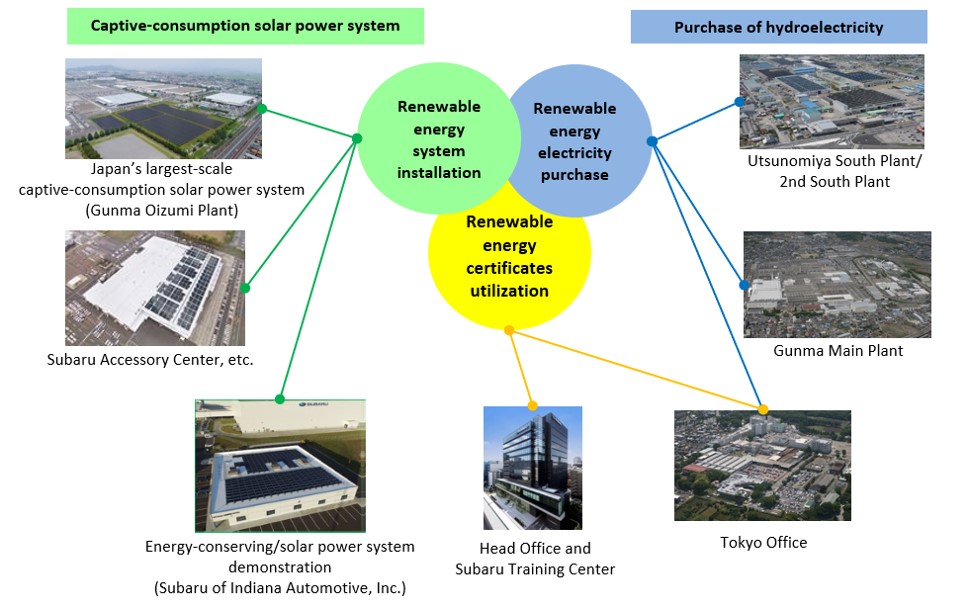Subaru’s unique features and technological innovation contribute to a carbon-free society
SUBARU CORPORATION
Outline
With the automotive and aerospace businesses as the pillars of Subaru’s operations, our fields of business are the earth, the sky and nature. Preservation of the ecosystem of our planet, the earth, the sky and nature, is of utmost importance to ensure the future sustainability of both society and our organization.
We position climate change as a pressing issue which has a particularly huge impact on society and the economy, and not only reduce CO₂ emissions from the vehicles we produce and sell, but also directly reduce CO₂ emissions from the Subaru Group's business sites.
Description
●Target
On the well-to-wheel*1 basis, we will pursue our goal of reducing the average CO₂ emissions from new passenger cars by at least 90% by 2050, compared with 2010. *2
*1. Well-to-wheel CO₂ emissions include all emissions from energy production through vehicle operation. In the case of electrified vehicles, emissions from primary energy sources used for electricity production are included.
*2. CO₂ emissions on the total volume basis. Emissions from vehicle operation calculated from official fuel economy figures. Changes in total sales volume due to market environment changes are taken into account, but not variations in driving distance.
●Roadmap
1. Products (Scope 3)
While thoroughly improving the fuel efficiency of our gasoline engine vehicles, we continue to develope more EVs and emphasize the " Subaru-ness" even in the environmental era.
Electric Vehicles—HVs, Plug-in Hybrid Vehicles (PHVs),Strong Hybrid Electric Vehicles (SHEVs), and Other Electromotive Vehicles (xEVs)
Subaru will expand its lineup of models equipped with the e-BOXER* power unit, which was developed by combining a horizontally opposed engine with electrification technology. We will also put on sale a unique plug-in hybrid vehicle developed by using the HV know-how possessed by Toyota Motor Corporation, and will develop a strong hybrid vehicle that provides both Subaru’s unique features and high environmental performance in the 2020s. Also, we will equip gasoline-powered vehicles with a range of electrification technologies to release xEVs with higher fuel efficiency. Subaru will expand the lineup of these electromotive vehicles in a planned manner with an eye to reducing CO₂ emissions from new models.
Electric Vehicles (EVs)
In June 2019, Subaru announced that it had reached an agreement with Toyo ta to jointly develop a platform for medium- to large-sized electric passenger vehicles as well as an electric SUV in the C-Segment class as its next step for remaining competitive in the coming age of electrification. By bringing together the technological strengths of two companies, including the electrification technology for which Toyota is fostering partnerships and the all-wheel drive (AWD) technology long accumulated by Subaru, the two will take on the challenge of making an attractive EV and releasing it in the first half of the 2020s.
We at Subaru will “develop and deliver products to meet societal needs and contribute to the environment through advanced technologies,” thereby contributing to the protection of the global environment. We will continue to develop EVs and expand our EV lineup, giving consideration to practical functions and customer preferences. We will thereby gradually increase the rate of environmentally friendly automobiles among our products for each market.
For more details, please refer to our news release.
Subaru Technology Meeting Held (January 20, 2020)
https://www.subaru.co.jp/press/file/uploads/news-en/en2020_0120_1.pdf
2. Plants and Office (Scope 1, 2)
While continuing energy conservation mainly, we are comprehensively promoting the utilization of renewable energy, the purchase of low-carbon and decarbonized energy, and the use of CO₂ credits as needed.
Although our direct CO₂ emissions (Scopes 1 and 2) constitute only a marginal portion of the total, we are making proactive efforts to diminish direct emissions, which we believe will encourage the entire Subaru value chain to work as a team and in greater earnest. Going forward, we will introduce cutting-edge energy conservation functions and renewable energy sources in order to further reduce CO₂ emissions and energy use.
For more details, please refer to our CSR Report.
https://www.subaru.co.jp/en/csr/report/pdf/2020/csr_report_2020_all.pdf#page=50
●Other Initiatives
Subaru is the first automobile manufacturer in the world*3 which concluded a Positive Impact Finance*4 (with unspecified use of funds) loan agreement.
In signing the agreement, a third-party opinion*5 has been obtained regarding the compliance with the Principles for Positive Impact Finance and the rationality of the evaluation indicators.
Subaru will continue contributing to achievement of the SDGs and the creation of a sustainable society.
*3 Based on research by Sumitomo Mitsui Trust Bank, Limited
*4 The Principles for Positive Impact Finance is a framework for finance established by UNEP FI in January 2017 with a view to achieving the UN Sustainable Development Goals (SDGs). Companies disclose key performance indicators (KPIs) for contributions to achieving SDGs, and banks provide finance after assessing the positive impact of such contributions. This framework guides efforts to increase positive impact and reduce negative impact from the activities of companies being financed. As responsible financial institutions, banks providing finance monitor indicators to ensure that positive impacts are continuing.
*5 For the independent opinion from Japan Credit Rating Agency, Ltd., please visit: https://www.jcr.co.jp/en/
Supplementary information
Subaru Holds Technology Briefing (January 20, 2020)
https://www.subaru.co.jp/press/news-en/2020_01_20_8244/
CSR Report
https://www.subaru.co.jp/en/csr/report/
Subaru Concludes Positive Impact Finance Loan Agreement (March 26, 2020)
Similar Innovation Challenges
Accelarating the penetration of renewable energy resources with “Open Energy System”
Sony Group Corporation
Achieving net-zero carbon emissions from plant factories using full artificial lighting
Taikisha Ltd.
Advanced technology for buildings providing energy-saving and comfortable indoor environment (under Net Zero Energy condition)
Mitsubishi Electric Corporation
AI control reduces base station power consumption by up to 50%
KDDI CORPORATION








